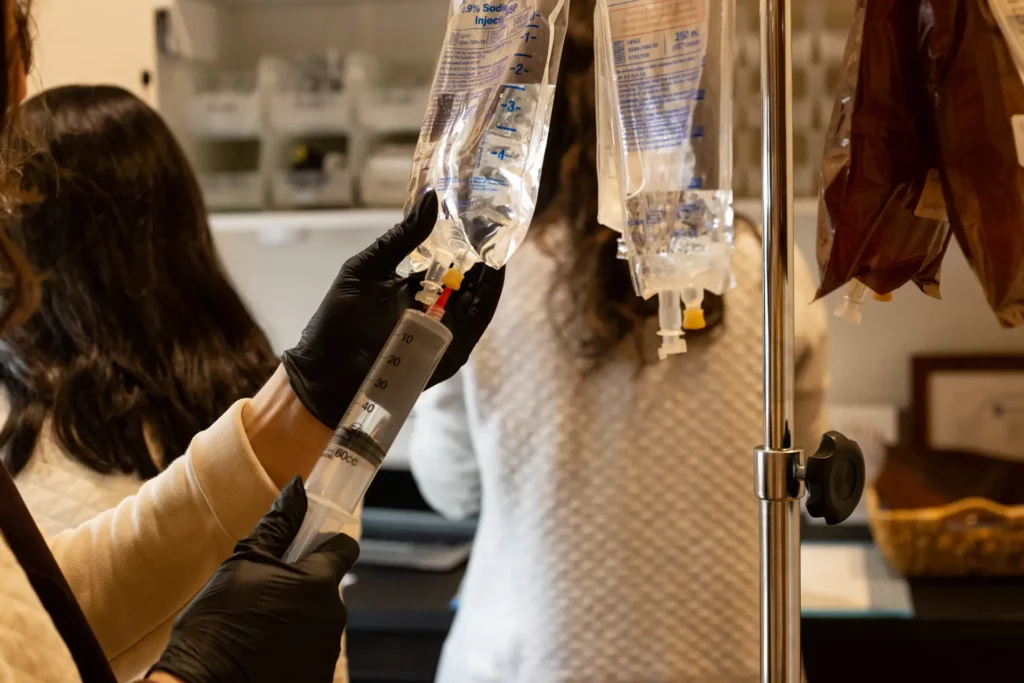
Lyme Disease Treatment in Philadelphia


Comprehensive Lyme Disease Treatment Beyond Antibiotics
The prevalence of Lyme Disease is increasing worldwide, yet there is a lack of awareness among physicians and healthcare providers regarding the extent of the problem and how to effectively detect and treat it. Even those providers who have some understanding of this intricate disease often possess limited knowledge about it. However, we have a comprehensive understanding of Lyme Disease and extensive experience in diagnosing and treating not only Lyme Disease but also other illnesses caused by ticks. We have a high success rate with assisting numerous individuals with Lyme Disease in reclaiming their well-being and resuming their lives. If you are struggling with this and have been unable to find solutions elsewhere, you have come to the right place. Continue reading to obtain all the essential information and discover how our distinctive approach to treating Lyme Disease at Meeting Point Health can aid in your recovery and enable you to live a fulfilling and complete life once again.
Understanding Lyme Disease:
There is growing recognition of a subset of patients who continue to experience persistent symptoms long after the initial infection. This phenomenon, known as chronic Lyme Disease, has sparked intense discussion within the medical community.
The concept of chronic Lyme Disease has been met with skepticism and controversy by some medical professionals. Critics argue that the symptoms experienced by patients are unrelated to Lyme Disease and instead may be due to other underlying conditions. However, there is a growing body of evidence that supports the existence of chronic Lyme Disease. Studies have shown that the bacterium responsible for Lyme, Borrelia burgdorferi, can persist in the body even after antibiotic treatment. This persistence has been demonstrated in animal models, where the bacteria have been found in various tissues and organs long after the initial infection. Furthermore, research has shown that the bacterium can evade the immune system and form protective structures called biofilms, which may contribute to its ability to persist in the body. In addition to the scientific evidence, the experiences of patients themselves provide further support for the existence of chronic Lyme. Many individuals report ongoing symptoms such as fatigue, joint pain, and cognitive difficulties, even years after being treated. These symptoms often wax and wane, with periods of remission followed by relapses, further highlighting the chronic nature of the Disease.
Symptoms of lyme disease:
Lyme Disease, caused by the bacterium Borrelia burgdorferi, can have various impacts on the body depending on the stage of infection. In the early stage, symptoms may include:
Fever
Headache
Extreme Tiredness
Joint Stiffness
Muscle aches and pains
Swollen lymph nodes
GI upset
These early symptoms are often flu-like and can be mistaken for other illnesses. If left untreated, Lyme Disease can progress to the later stages, leading to more severe symptoms and complications. In the late stage, symptoms and complications can become more severe and widespread. These may include:
Facial paralysis
Arthritis
Neurological problems
Headaches / migraine
Heart problems
Fluid accumulation
Some individuals may also experience persistent symptoms even after receiving antibiotic treatment, referred to as chronic Lyme Disease. These symptoms can include:
Pain
Fatigue
Cognitive difficulties / brain fog
Nerve problems
The long-term effects of untreated Lyme Disease can have a significant impact on an individual’s quality of life.
The symptoms can vary widely, making it difficult to diagnose. In some cases, a characteristic rash known as erythema migrans may develop at the site of the tick bite. However, this rash is not always present, further complicating the diagnostic process. To diagnose Lyme Disease, healthcare providers rely on a combination of clinical evaluation and laboratory tests. Blood tests can detect the presence of antibodies to the bacteria, but these tests are not always reliable, especially in the early stages of the Disease. Additionally, the symptoms of Lyme Disease can mimic those of other conditions, leading to misdiagnosis or delayed diagnosis.
Testing for Lyme Disease
Diagnosing Lyme Disease can be challenging since its symptoms can mimic those of other illnesses. However, clinical symptoms, such as the characteristic bull’s-eye rash called erythema migraines, can be indicative of Lyme, but only present in less than 10% of cases!
The most common diagnostic method in conventional medicine is a combination of the Western blot and ELISA tests, which measure specific antibodies produced in response to the bacteria. These tests are widely accepted and utilized in conventional medicine for diagnosing Lyme Disease. However, there have been concerns about false negatives and the limitations of these tests in accurately detecting the Disease. Some of the limitations and potential problems are related to the sensitivity and specificity of these tests::
Timing of Testing: If testing is performed too early in infection, the results may be negative, even if the person has Lyme disease. It is generally recommended to wait a few weeks after the onset of symptoms before testing to increase the chances of accurate results. This is a sensitivity problem.
Cross-Reactivity: The ELISA and Western blot tests can sometimes cross-react with antibodies produced in response to other infections, leading to false-positive results. This is a specificity problem.
Coinfections: The ELISA and Western blot only cover borrelia burgdorferi. No other Coinfections are tested alongside these tests usually. This is a specificity problem.
Interpretation Challenges: Interpreting the test results can be complex, especially when there is a discrepancy between the ELISA and Western blot results. Some patients may have positive ELISA results but negative Western blot results, leading to uncertainty in diagnosis. In addition, criteria for a positive Lyme diagnosis involve seeing 5 IgG antibodies or 2 IgM bodies. Many patients have walked away with a false negative because they did not meet exact criteria.
Chronic Lyme Disease: The tests may have reduced sensitivity in detecting Lyme disease in its chronic stage, partly because borrelia burgdorferi is a spirochete bacteria and can coil in on itself making it undetectable to the immune system. This bacteria is very effective in evading detection also because of the phlegm biofilms it creates to protect it against your immune cells.
At Meeting Point Health, we use the comprehensive Tick-Borne Panel from Vibrant Labs to test for all the multiple strains of Borrelia as well as the numerous Coinfections possible with tick bites. Read this medical journal article for why we use the microarray immunochip by Vibrant Labs to get a correct diagnosis.
Lyme Coinfections
Lyme co-infections, which occur when an individual is infected with multiple tick-borne pathogens in addition to Lyme Disease, can present with a wide range of symptoms. While some symptoms may overlap with those of Lyme Disease, there are also distinct differences depending on the specific coinfection. Some of the common co-infections include:
Babesia
Anaplasma
Ehrlichia
Bartonella
Mycoplasma
Powassan Virus
Epstein Barr Virus
Cytomegalovirus
HHV6
These coinfections create neurological complications such as light sensitivity, pain, pressure, blurred vision, anxiety and double vision. Many patients with bartonella complain of strange neurological sensations like worms, ocean waves, buzzing or tingling, especially in the feet. Only a Lyme literate provider would recognize these symptoms as Bartonellosis.
One of the key characteristics of Lyme coinfections is the increased severity and duration of illness compared to Lyme Disease alone. Research has found that patients co-infected with Lyme Disease and other tick-borne Diseases experienced a greater number of symptoms and a longer duration of illness. Additionally, studies have shown that patients with acute Babesia and/or Bartonella coinfections have more severe symptoms and a longer duration of illness compared to those with Lyme Disease alone. These findings highlight the challenges and complexities associated with managing coinfections and emphasize the importance of early detection and treatment.
How Common is Lyme disease?
Lyme Disease today is not what it was 30 years ago, and there is a great deal of outdated information. Conventionally, doctors would be looking for a bulls-eye rash, flu-like symptoms, and a story related to being in the woods. If we checked all the boxes, the physician would diagnose Lyme Disease, possibly run a blood test, and treat it with necessary antibiotics. Because of the likelihood of misdiagnosis, detection rates are much lower than in reality.
However, diagnosis and treatment are very different now. Lyme is no longer confined to the Northeastern United States anymore. The organism that causes Lyme called Borrelia Burgdorferi has morphed over the years. In addition, there are hundreds of other tick-borne diseases from other bacteria, viruses, and fungi in the same tick. One bite can cause many infections. One can easily get Lyme without a rash or possibly with the smallest of rashes in a belly button or groin area, without ever seeing it. Ticks especially like to find creases such as the back of the knee, ankle, groin area, armpit, or behind the ear.
It is possible to have been infected without any memory of being bitten by a tick, or you may have knowledge of being bitten but never developed a rash. In either case, Lyme disease can absolutely develop. This is typically because the infected tick is usually in a nymph stage, too small to detect. All of this makes detection rates very challenging.
Lyme Disease Treatment with Functional Medicine
In cases of chronic Lyme Disease, where symptoms persist or recur after initial treatment of antibiotics, conventional medicine may struggle to provide effective solutions — or worse continue antibiotic therapy for months or even years! This limitation has led many individuals to seek alternative approaches, such as functional medicine.
Functional medicine takes a comprehensive and holistic approach to chronic Lyme, addressing not only the infection, but also the underlying imbalances and dysfunctions of various systems in the body — especially the immune, nervous, gastrointestinal, musculoskeletal and cardiovascular systems. The functional medicine approach focuses on personalized treatment plans that may include a combination of lifestyle changes, dietary modifications, supplementation, herbal therapy, and targeted infusion therapies to support the body’s natural ability to fight off the infection and promote healing. By taking into account the whole health of the individual, functional medicine offers an alternative approach to the conventional medicine model of Lyme treatment.
Early intervention with antibiotics (first 2 weeks of a tick bite) should kill the bacteria, but if you’ve had Lyme disease for a while, you will need intravenous therapy too. Meeting Point also offers therapies that can:
- kill pathogens of Lyme disease, coinfections and toxins
- restore immune, gastrointestinal and cardiovascular health
- ease symptoms related to fatigue, brain fog and pain
Some of the therapies we use include:
Peptides are short chains of amino acids that can have various biological functions, including antimicrobial and immunomodulatory properties.
Researchers have been investigating different peptides, such as LL-37, KPV, and Thymosin alpha 1 (Tα1), for their potential to target the bacterium Borrelia burgdorferi, which causes Lyme, and to modulate the immune response.
- LL-37 is a naturally occurring antimicrobial peptide found in human immune cells, and it has shown broad-spectrum activity against various pathogens, including the bacteria responsible for Lyme disease.
- KPV is derived from a protein called decorin, which is naturally present in the body and plays a role in regulating inflammation and tissue repair. Some studies have suggested that KPV have anti-inflammatory and antimicrobial properties, which could be relevant in the context of Lyme disease.
- Thymosin Alpha 1 – Tα1 is a synthetic peptide derived from a naturally occurring thymic hormone, and it is known to play a role in modulating the immune system and enhancing immune responses, such as promoting the production of certain immune cells and cytokines that are essential for immune function.
- GHK-cu – because Lyme disease primarily affects tissues, such as collagen in the joints, skin, and nerves, this peptide maybe be very beneficial, because it promotes hyper-healing in soft tissue.
Herbal remedies that have been studied in the treatment of chronic Lyme have been shown to be effective and beneficial. Herbs drawn for the Buhner Protocol, the Cowden Protocol and Traditional Chinese Medicine are found to have antimicrobial, anti-inflammatory, and immune-enhancing properties. There are many herbs to consider. Some of the main herbs used include:
- Japanese Knotweed: Known for its anti-inflammatory and antimicrobial properties
- Andrographis: immune-stimulating and antimicrobial effects
- Cat’s Claw: antimicrobial properties.
- Sarsaparilla: anti-inflammatory properties
- Eleuthero : also known as Siberian ginseng, supports the immune system and increases stamina.
- Chinese Skullcap: anti-inflammatory properties
- Cordyceps: a medicinal mushroom believed to have immune-modulating effects.
- Hawthorn: cardiovascular benefits, as Lyme disease can affect the heart in some cases.
- Coptis: also known as Chinese Goldthread, contains high amounts and of berberine which has antimicrobial properties
Herbal Therapy has its limitations however when used as a stand alone treatment. If you have been using herbals for the treatment of Lyme and not seeing improvement, it is time to see a Lyme specialist.
Acupuncture is a traditional Chinese medicine technique that involves inserting thin needles into specific points on the body to stimulate and balance the flow of energy in the blood, lymph, fascia and nerves. As a complementary therapy to infusions and herbs, it can to help manage symptoms and improve overall well-being for individuals with chronic Lyme disease:
- Pain Management: Lyme disease can cause various types of pain, such as joint pain, muscle aches, nerve pain, and migraines. Acupuncture has been known to promote the release of endorphins and other natural pain-relieving chemicals in your body, potentially helping to reduce pain and discomfort.
- Stress Reduction: Chronic Lyme disease can be physically and emotionally challenging. Acupuncture has been shown to have a significant calming effect on the nervous system, helping to reduce stress, anxiety, and improve sleep.
- Immune System Support: Acupuncture is believed to help balance the body’s energy and strengthen the immune system. A well-functioning immune system is essential for combating infections, including Lyme disease.
To benefit from a comprehensive, functional approach to treating Lyme disease, call Meeting Point today, or request an appointment online.
Chronic Lyme is a controversial condition that some individuals may experience even after receiving treatment for Lyme Disease. It is characterized by persistent symptoms that can last for months or even years. It is important for individuals experiencing persistent symptoms after Lyme Disease to seek medical attention and work with healthcare professionals to manage their symptoms and improve their overall well-being.
Soul-Centered Healthcare As a Catalyst For Change
Many people suffer with undiagnosed or misdiagnosed conditions and simply don’t know what’s wrong with them or what will help. We understand what it’s like to feel trapped in a body that is not working for you! At Meeting Point Health, we find the root cause and use a proven, integrative approach that gets results. As highly trained pioneers in functional and regenerative medicine, we’ve helped thousands of patients take control of their health.
OUR PATIENTS FIND RELIEF HERE
Our Patients Find Relief Here
EXCELLENT
We’re here to answer all of your questions
At Meeting Point, we understand that every condition stems from an imbalance elsewhere in the body. We aim to find and heal that imbalance so you can live a richer, healthier life. Meeting Point’s integrative healthcare solutions can help you eliminate nail fungus and stop it from returning.
Call to schedule your initial consultation with one of our expert healthcare providers if you’re ready to experience what compassionate, holistic care can do for you.
Does Meeting Point Health accept insurance?
Meeting Point Health does not accept insurance.
Our practitioners and staff fully understand and empathize with the challenges that patients face as they make financial decisions for proper health care. Our practice is very different from a conventional medical practice in many ways, but the time spent with each patient is usually 30-90 minutes. Visits with a physician covered by insurance generally allow for less than 10 minutes in total! Conventional medical practices that take insurance maintain brief office visits and high patient loads for this reason. We cannot provide the expert care that every one of our patients deserves under those circumstances.
Insurance also dictates the types of treatments and order of treatments patients can receive for a particular condition.
Opting out of insurance allows the patient and the doctor to maintain their medical autonomy, which is imperative to ensure you get the right treatment at the right time and the right dose.
How do I get started with Meeting Point Health?
To start your journey to relief, schedule a consultation with our team. During your initial visit, we’ll assess your medical history, perform a thorough evaluation, and develop a customized treatment plan to address your specific needs. Click to schedule a free discovery call with one of our Patient Onboarding Specialists today!
fast-track your health with Meeting Point Health
request your appointment today!
Sources & References:
Centers for Disease Control and Prevention (CDC): The CDC provides comprehensive information on Lyme Disease, its symptoms, diagnosis, treatment, and prevention. Their website is a reliable source for public health information. Website: https://www.cdc.gov/lyme/index.html
Mayo Clinic: The Mayo Clinic offers a wealth of information on various medical conditions, including Lyme Disease. Their articles are well-researched and often reviewed by medical professionals. Website: https://www.mayoclinic.org/diseases-conditions/lyme-disease/symptoms-causes/syc-20374651
National Institute of Allergy and Infectious Diseases (NIAID): NIAID provides research-based information on infectious diseases, including Lyme Disease. It offers insights into the latest research and developments in the field. Website: https://www.niaid.nih.gov/diseases-conditions/lyme-disease
PubMed: PubMed is a widely used database for medical literature. You can search for specific research articles related to Lyme Disease and its treatment. Website: https://pubmed.ncbi.nlm.nih.gov/
International Lyme and Associated Diseases Society (ILADS): ILADS is an organization dedicated to promoting understanding and treatment of Lyme Disease. Their website provides information on the latest research and treatment guidelines. Website: https://www.ilads.org/
Johns Hopkins Medicine: Johns Hopkins provides patient education resources on various medical conditions. Their Lyme Disease section covers symptoms, diagnosis, and treatment options. Website: https://www.hopkinsmedicine.org/health/conditions-and-diseases/lyme-disease
Vibrant Wellness: Vibrant Wellness offers advanced diagnostic testing, including the Tick-Borne Panel mentioned in your content. Website: https://www.vibrant-wellness.com/tick-borne-disease

